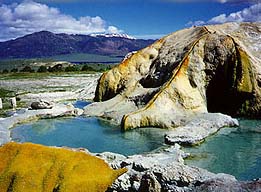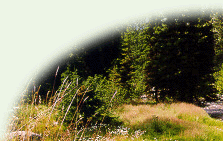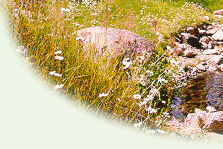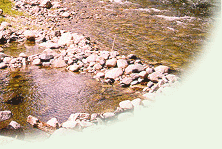
What
is a geothermal spring?
“U.S. textbooks on the subject define hot springs as any
spring or well whose water temperature noticeably exceeds the average ambient
air temperature. Europe classifies any spring with a temperature above 20°C
(68°F) as thermal. In the United States, the spring’s calls thermal
or hot are those with temperatures at least 15°F
above the mean annual temperatures of the air.” (Kaysing)
How
are geothermal springs heated?
“Theoretically, the elevated temperatures stem from two major sources.
First: stored heat energy transformed from kinetic energy it took from the
earth. Second: radioactive elements generating energy from the decay of atomic
structures (like a nuclear reactor).” (Kaysing)
So in simpler terms, the springs are heated by enery released from within the earth. This energy is then transfered to water within the earth and when those waters reach the surface they form geothermal springs.
Are
there safety issues?
The condition of geothermal springs is not fixed. As previously mentioned
they can fluctuate in temperature which can be reason for caution. Find spring
condition information before venturing to a specific spring location if you
are expecting to take a lesiurely soak. Always do a test of the waters before
entering a geothermal spring . Even familiar springs can flucuate in temperature
without warning so be careful!
Being able to enjoy geothermal springs is a privliage. It is important to
be aware of the surrounding environment and to be cautious not to disturb
these areas. Preserving the natural undisturbed qualities of the spring is
important and can be accomplished by keeping the areas clean and debris free.
Taking trash home with you instead of leaving it in these natural areas is
one important step. Also remember to keep the waters clean and natural by
not adding any foreign materals to the water. Remember to return home with
all the items you came with and alwys use caution and common sense when entering
the springs.
Are
there different types of springs?
There are many different types of geothermal springs. They can vary in area,
temperature, and depth. Some, such as Fales Hot Spring, have waters that come
from depths 7,000 feet below the surface! Other variations in springs include
the commercial or non-commercial status. Some springs have had luxurious resorts
built up around them. These resorts can vary in amenities, style and cost.
There are also hot springs that have been preserved in a natural state (some
with minimal sandbagging to keep the waters contained).
Just as a side note, some ‘hot springs’ parks or resorts are not
natural mineral spring waters, but heated tap water. Check out some sites
form our liks page to get details about different types of hot springs.
For more geothermal information check
out these websites:




Springs have many varying factors including the rate of flow, temperature, and mineral content, to name just a few. Flow rate can range anywhere from a minimal trickle to thousands of gallons per minute. There are a wide variety of temperatures for springs from cool to boiling and beyond! Many different minerals can exist in and around geothermal springs. Some minerals found in geothermal waters include sulfer, known to be good for the skin and Lithium, which is said to attribute to the relaxing quality of some geothermal springs.
